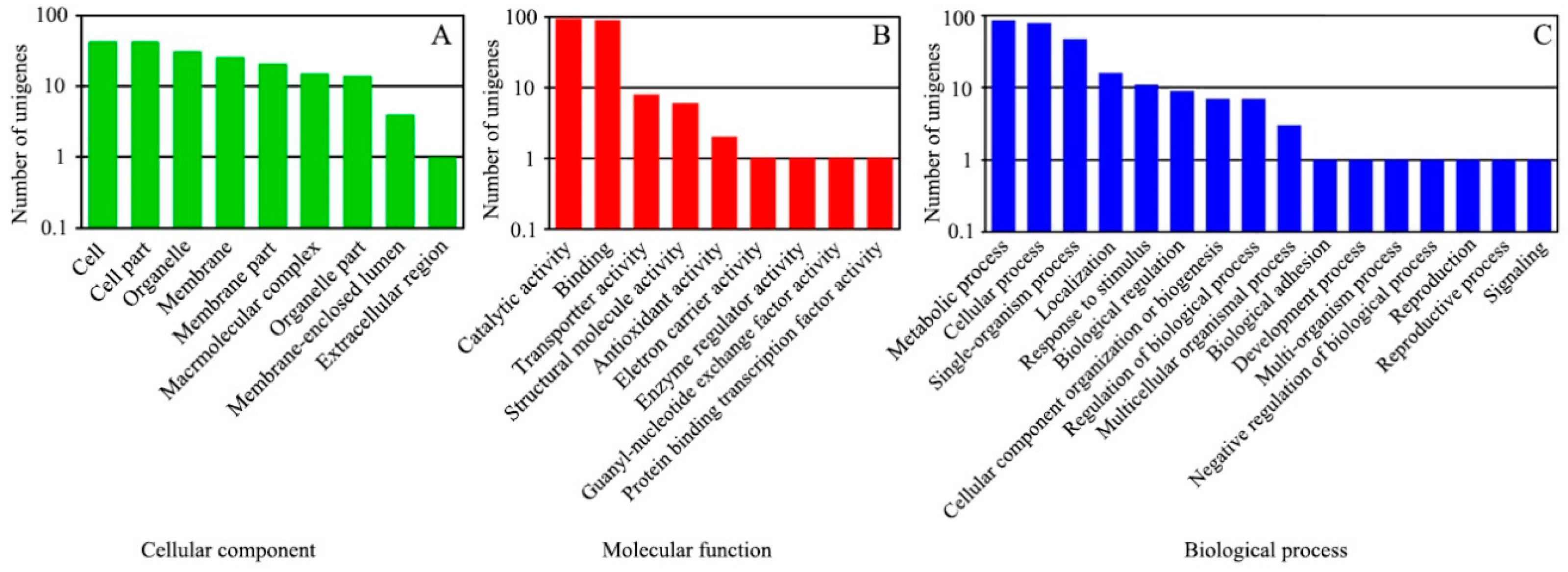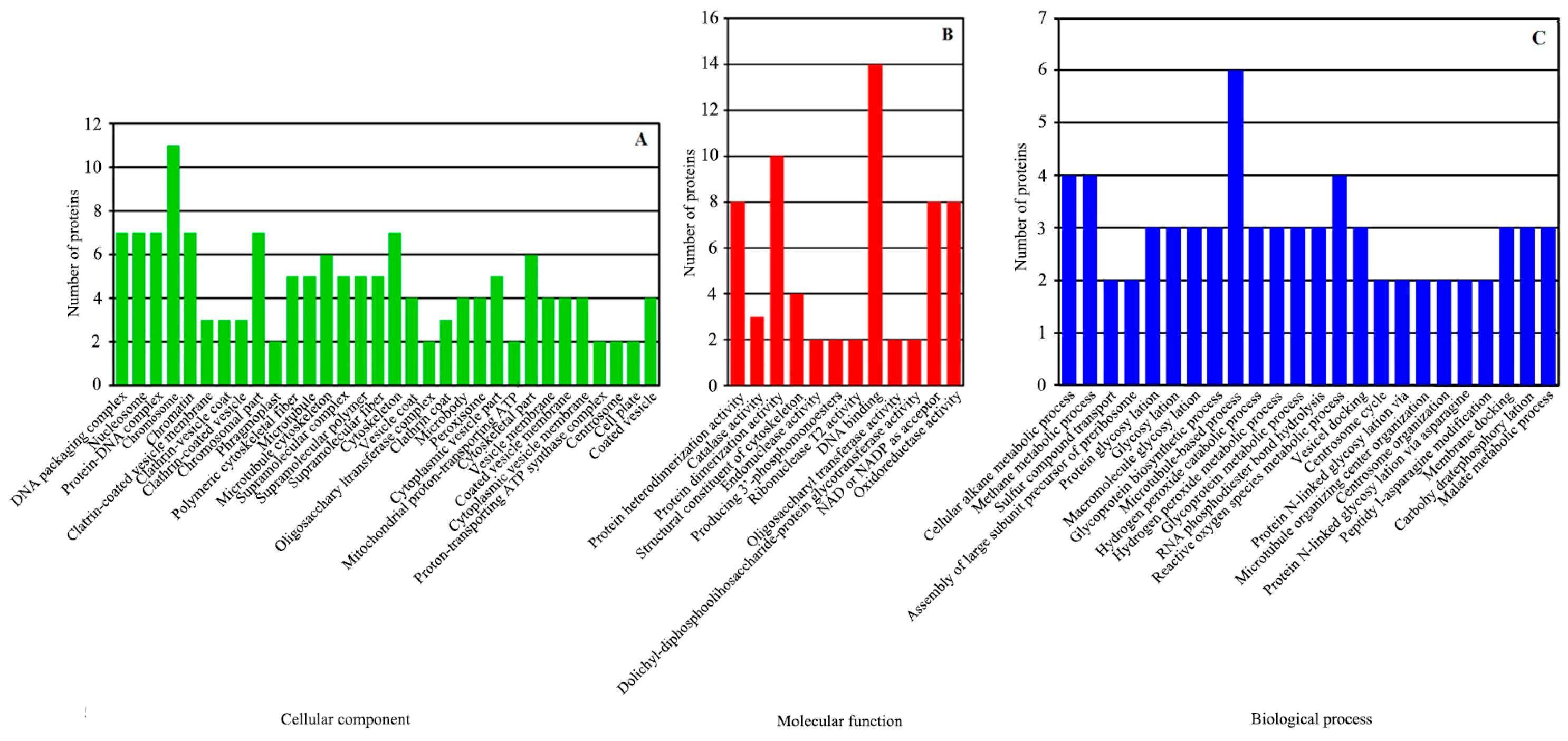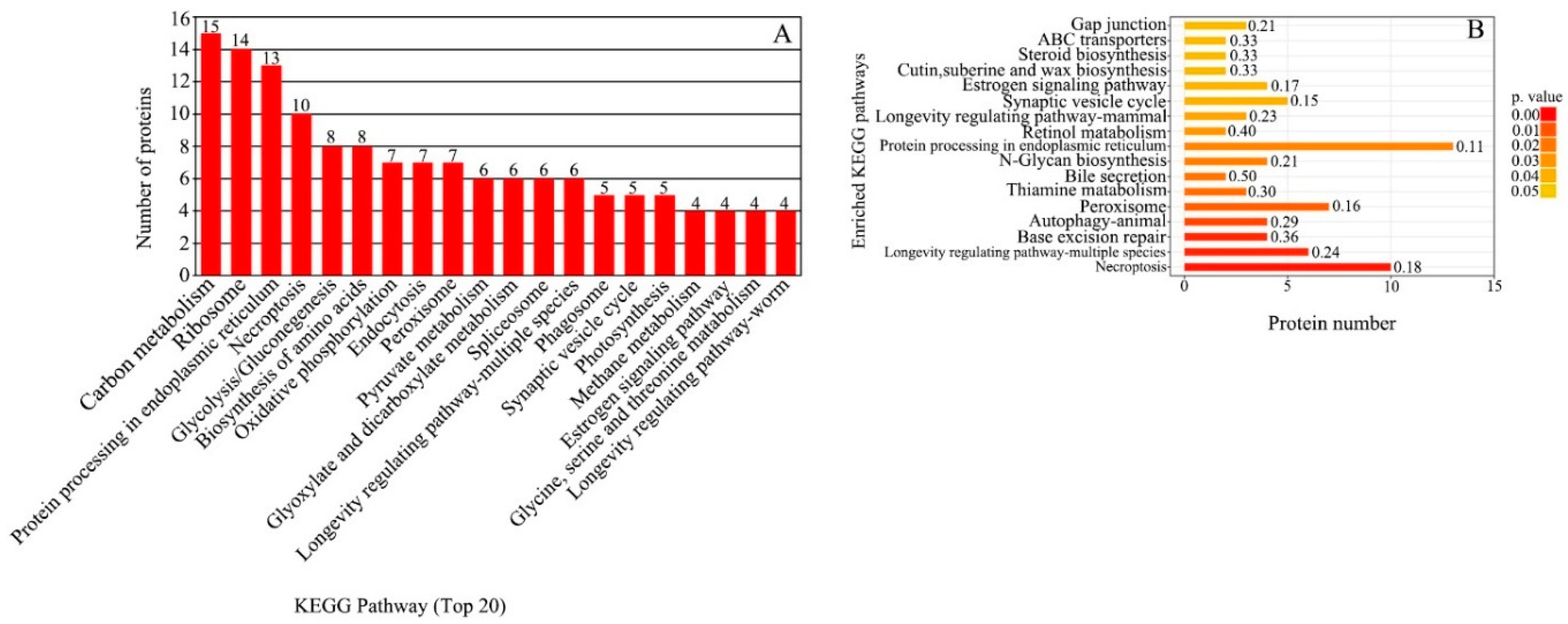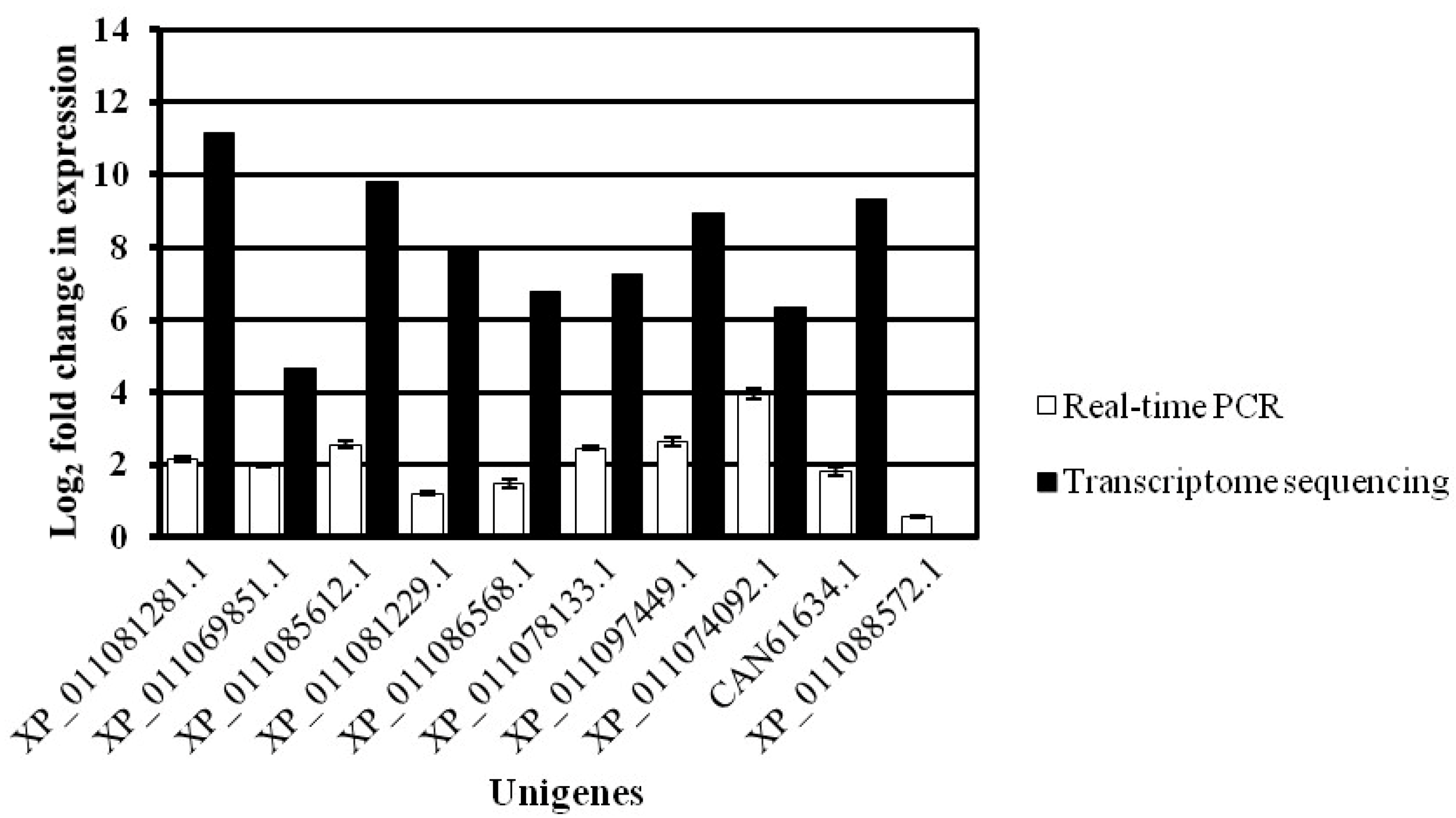Transcriptome and Proteome Analysis Identified Genes/Proteins Involved in the Regulation of Leaf Color in Paulownia fortunei
Abstract
:1. Introduction
2. Materials and Methods
2.1. Plant Materials
2.2. Chlorophyll Content Measurements
2.3. Transcriptome Sequencing and Identification of Differentially Expressed Genes (DEGs)
2.4. Extraction and Detection of Proteins and Identification of DEPs
2.5. Data Analysis
2.6. qRT-PCR Analysis
3. Results
3.1. Physiological Characteristics of P. fortunei Mutant Deficient in Greening
3.2. Transcriptome Sequencing Analysis
3.3. DEG Analysis and Functional Annotation
3.4. GO Functional Analysis of DEGs
3.5. KEGG Functional Annotation of DEGs
3.6. Protein Information Identified by ITRAQ
3.7. GO Functional Analysis of DEPs
3.8. KEGG Function Annotation and Analysis of DEPs
3.9. Correlation Analysis Between Transcriptome and Proteome
3.10. DEGs/DEPs Related to Leaf Color Regulation in P. fortunei
3.11. Validation of DEGs Expression
4. Discussion
5. Conclusions
Supplementary Materials
Author Contributions
Funding
Data Availability Statement
Conflicts of Interest
References
- Sławińska, N.; Zając, J.; Olas, B. Paulownia Organs as Interesting New Sources of Bioactive Compounds. Int. J. Mol. Sci. 2023, 24, 1676. [Google Scholar] [CrossRef]
- Ru, G.X.; Liu, X.N.; Zhu, X.H.; Zhang, L.C.; Wang, Y.R.; Zhou, S.Q. Physiological Characteristic Analysis of Etiolation Mutant in Paulownia fortune. J. Nanjing For. Univ. (Nat. Sci. Ed.) 2017, 41, 181–185. (In Chinese) [Google Scholar]
- Zivcak, M.; Brestic, M.; Botyanszka, L.; Chen, Y.E.; Allakhverdiev, S.I. Phenotyping of Isogenic Chlorophyll-less Bread and Durum Wheat Mutant Lines in Relation to Photoprotection and Photosynthetic Capacity. Photosyn. Res. 2018, 139, 239–251. [Google Scholar] [CrossRef] [PubMed]
- Yang, Y.N.; Safarova, R.B.; Park, S.Y.; Sakuraba, Y.; Oh, M.H.; Zulfugarov, I.S.; Lee, C.B.; Tanaka, A.; Paek, N.C.; Lee, C.H. Chlorophyll Degradation and Light-harvesting Complex II Aggregate Formation during Dark-induced Leaf Senescence in Arabidopsis Pheophytinase Mutants. J. Plant Biol. 2019, 62, 27–38. [Google Scholar] [CrossRef]
- Lin, W.W.; Guo, X.D.; Pan, X.F.; Li, Z.W. Chlorophyll Composition, Chlorophyll Fluorescence, and Grain Yield Change in es/mutant Rice. Int. J. Mol. Sci. 2018, 19, 2945. [Google Scholar] [CrossRef] [PubMed]
- Sakowska, K.; Alberti, G.; Genesio, L.; Peressotti, A.; Delle Vedove, G.; Gianelle, D.; Colombo, R.; Rodeghiero, M.; Panigada, C.; Juszczak, R. Leaf and Canopy Photosynthesis of a Chlorophyll Deficient Soybean Mutant. Plant Cell Environ. 2018, 41, 1427–1437. [Google Scholar] [CrossRef]
- Shi, D.Y.; Zheng, X.; Li, L.; Lin, W.H.; Xie, W.J.; Yang, J.P.; Chen, S.J.; Jin, W.W. Chlorophyll Deficiency in the Maize Elongated Mesocotyl 2 Mutant is Caused by a Defective Heme Oxygenase and Delaying Grana Stacking. PLoS ONE 2013, 8, e80107. [Google Scholar] [CrossRef]
- Dong, H.; Zeng, H. Identification of Differentially Expressed Proteins of a New Rice Mutant with Albino Green-revertible Trait in the Seedling Stage. Can. J. Plant Sci. 2010, 90, 283–292. [Google Scholar] [CrossRef]
- Chu, P.; Yan, G.X.; Yang, Q.; Zhai, L.N.; Zhang, C.; Zhang, F.Q.; Guan, R.Z. iTRAQ-based Quantitative Proteomics Analysis of Brassica napus Leaves Reveals Pathways Associated with Chlorophyll Deficiency. J. Proteom. 2015, 113, 244–259. [Google Scholar] [CrossRef]
- Dong, F.; Shi, Y.Z.; Liu, M.Y.; Fan, K.; Zhang, Q.F.; Ruan, J. iTRAQ-based Quantitative Proteomics Analysis Reveals the Mechanism Underlying the Weakening of Carbon Metabolism in Chlorotic Tea Leaves. Int. J. Mol. Sci. 2018, 19, 3943. [Google Scholar] [CrossRef]
- Huang, B.; Huang, W.; Liu, Z.; Peng, Y.; Qu, Y.; Zhou, W.; Huang, J.; Shu, H.; Wen, Q. Cytological, Physiological, and Transcriptome Analysis of Leaf-Yellowing Mutant in Camellia chekiangoleosa. Int. J. Mol. Sci. 2024, 26, 132. [Google Scholar] [CrossRef]
- Gong, Z.H.; Chen, S.H.; Li, X.Y.; Lv, W.W.; Li, M.R.; Jin, X.M.; Gao, Y.F.; Rong, L.P. Anthocyanin metabolites and related regulatory genes analysis in leaves of Acer Pseudosieboldianum mutant during different periods of color change. BMC Genom. 2025, 26, 182. [Google Scholar] [CrossRef]
- Lichtenthaler, H.K. Chlorophylls and carotenoids: Pigments of photosynthetic biomembranes. Method. Enzymol. 1987, 148, 350–382. [Google Scholar]
- Mortazavi, A.; Williams, B.A.; McCue, K.; Schaeffer, L.; Wold, B. Mapping and quantifying mammalian transcriptomes by RNA-Seq. Nat. Methods 2008, 5, 621–628. [Google Scholar] [CrossRef]
- Jorrin-Novo, J.V. Plant proteomics methods and protocols. Plant Proteom. 2014, 1072, 3–13. [Google Scholar]
- Xiao, C.; Ye, J.; Máximo Esteves, R.; Rong, C. Using Spearman’s correlation coefficients for exploratory data analysis on big dataset. Concurr. Comp. Pract. E 2016, 28, 3866–3878. [Google Scholar] [CrossRef]
- Deng, Y.Y.; Li, J.Q.; Wu, S.F.; Zhu, Y.P.; He, F.C. Integrated NR database in protein annotation system and its localization. Comput. Eng. 2006, 32, 71–72. [Google Scholar]
- Tatusov, R.L.; Galperin, M.Y.; Natale, D.A.; Koonin, E.V. The COG database: A tool for genome scale analysis of protein functions and evolution. Nucleic Acids Res. 2000, 28, 33–36. [Google Scholar] [CrossRef]
- Conesa, A.; Götz, S. Blast2GO: A comprehensive suite for functional analysis in plant genomics. Inter. J. Plant Genom. 2008, 2008, 619832. [Google Scholar] [CrossRef]
- Kanehisa, M.; Goto, S.; Sato, Y.; Furumichi, M.; Tanabe, M. KEGG for integration and interpretation of large-scale molecular data sets. Nucleic Acids Res. 2012, 40, D109–D114. [Google Scholar] [CrossRef]
- Livak, K.; Schmittgen, T. Analysis of relative gene expression data using real-time quantitative PCR and the 2−∆∆CT method. Methods 2001, 25, 402–408. [Google Scholar] [CrossRef]
- Wang, Y.L.; Wang, C.M.; Zheng, M.; Lyu, J.; Xu, Y.; Li, X.H.; Niu, M.; Long, W.H.; Wang, D.; Wang, H.Y.; et al. WHITE PANICLE1, a Val-tRNA synthetase regulating chloroplast ribosome biogenesis in rice, is essential for early chloroplast development. Plant Physiol. 2016, 170, 2110–2123. [Google Scholar] [CrossRef]
- Stange-Thomann, N.; Thomann, H.U.; Lloyd, A.J.; Lyman, H.; Söll, D. A point mutation in Euglena gracilis chloroplast tRNA(Glu) uncouples protein and chlorophyll biosynthesis. Proc. Natl. Acad. Sci. USA 1994, 91, 7947–7951. [Google Scholar] [CrossRef]
- Schön, A.; Gough, S.; Söll, D. Chloroplast tRNA(Asp): Nucleotide sequence and variation of in vivo levels during plastid maturation. Plant Mol. Biol. 1992, 20, 601–607. [Google Scholar] [CrossRef]
- Zhang, X.; Ma, F.; Zhu, X.; Zhu, J.Y.; Rong, J.F.; Zhan, J.; Chen, H.; He, C.L.; Wang, Q. The acceptor side of photosystem II is the initial target of nitrite stress in Synechocystis sp. strain PCC 6803. Appl. Environ. Microbiol. 2017, 83, e02952-16. [Google Scholar] [CrossRef]
- Chatterjee, A.; Kundu, S. Revisiting the chlorophyll biosynthesis pathway using genome scale metabolic model of Oryza sativa japonica. Sci. Rep. 2015, 5, 14975. [Google Scholar] [CrossRef]
- Zhen, S.; van Iersel, M.W. Far-red light is needed for efficient photochemistry and photosynthesis. J. Plant Physiol. 2017, 209, 115–122. [Google Scholar] [CrossRef]
- Zhu, J.; Wang, W.S.; Ma, D.; Zhang, L.Y.; Ren, F.; Yuan, T.T. A role for CK2 β subunit 4 in the regulation of plant growth, cadmium accumulation and H2O2 content under cadmium stress in Arabidopsis thaliana. Plant Physiol. Biochem. 2016, 109, 240–247. [Google Scholar] [CrossRef]
- Bu, Q.Y.; Zhu, L.; Dennis, M.D.; Yu, L.; Lu, S.X.; Person, M.D.; Tobin, E.M.; Browning, K.S.; Huq, E. Phosphorylation by CK2 enhances the rapid light-induced degradation of phytochrome interacting factor 1 in Arabidopsis. J. Biol. Chem. 2011, 286, 12066–12074. [Google Scholar] [CrossRef]
- Li, F.Q.; Murillo, C.; Wurtzel, E.T. Maize Y9 encodes a product essential for 15-cis-zeta-carotene isomerization. Plant Physiol. 2007, 144, 1181–1189. [Google Scholar] [CrossRef]
- Ohashi, K.; Tanaka, A.; Tsuji, T. Formation of the photosynthetic electron transport system during the early phase of greening in barley leaves. Plant Physiol. 1989, 91, 409–414. [Google Scholar] [CrossRef] [PubMed]
- Chen, H.L.; Li, C.R.; Liu, L.P.; Zhao, J.Y.; Cheng, X.Z.; Jiang, G.H.; Zhai, W.S. The Fd-GOGAT1 mutant gene lc7 confers resistance to Xanthomonas oryzae pv. oryzae in rice. Sci. Rep. 2016, 6, 26411. [Google Scholar] [CrossRef]
- Robison, M.M.; Ling, X.Y.; Smid, M.P.L.; Zarei, A.; Wolyn, D.J. Antisense expression of mitochondrial ATP synthase subunits OSCP (ATP5) and (ATP3) alters leaf morphology, metabolism and gene expression in Arabidopsis. Plant Cell Physiol. 2009, 50, 1840–1850. [Google Scholar] [CrossRef] [PubMed]
- Ardelean, I.; Matthijs, H.C.P.; Havaux, M.; Joset, F.; Jeanjean, R. Unexpected changes in photosystem I function in a cytochrome c6-deficient mutant of the cyanobacterium Synechocystis PCC 6803. FEMS Microbiol. Lett. 2002, 213, 113–119. [Google Scholar] [CrossRef]
- Zeng, F.R.; Qiu, B.Y.; Wu, X.J.; Niu, S.N.; Wu, F.B.; Zhang, G.P. Glutathione-mediated alleviation of chromium toxicity in rice plants. Biol. Trace Elem. Res. 2012, 148, 255–263. [Google Scholar] [CrossRef]
- Zhang, F.; Zhang, P.; Zhang, Y.; Wang, S.C.; Qu, L.H.; Liu, X.Q.; Luo, J. Identification of a peroxisomal-targeted aldolase involved in chlorophyll biosynthesis and sugar metabolism in rice. Plant Sci. 2016, 250, 205–215. [Google Scholar] [CrossRef]
- Patro, L.; Mohapatra, P.K.; Biswal, U.C.; Biswal, B. Dehydration induced loss of photosynthesis in Arabidopsis leaves during senescence is accompanied by the reversible enhancement in the activity of cell wall β-glucosidase. J. Photochem. Photobiol. B 2014, 137, 49–54. [Google Scholar] [CrossRef]
- Wu, Z.M.; Zhang, X.; Wang, J.L.; Wan, J.M. Leaf chloroplast ultrastructure and photosynthetic properties of a chlorophyll-deficient mutant of rice. Photosynthetica 2014, 52, 217–222. [Google Scholar] [CrossRef]
- Wu, Z.M.; Zhang, X.; He, B.; Diao, L.P.; Sheng, S.L.; Wang, J.L.; Guo, X.P.; Su, N.; Wang, L.F.; Jiang, L.; et al. A chlorophyll-deficient rice mutant with impaired chlorophyllide esterification in chlorophyll biosynthesis. Plant Physiol. 2007, 145, 29–40. [Google Scholar] [CrossRef]
- Gutiérrez-Nava, M.D.L.; Gillmor, C.S.; Jiménez, L.F.; Guevara-García, A.; León, P. Chloroplast biogenesis genes act cell and noncell autonomously in early chloroplast development. Plant Physiol. 2004, 135, 471–482. [Google Scholar] [CrossRef]
- Falbel, T.G.; Staehelin, L.A. Partial blocks in the early steps of the chlorophyll synthesis pathway: A common feature of chlorophyll b-deficient mutants. Physiol. Plant 1996, 97, 311–320. [Google Scholar] [CrossRef]
- Satou, M.; Enoki, H.; Oikawa, A.; Ohta, D.; Saito, K.; Hachiya, T.; Sakakibara, H.; Kusano, M.; Fukushima, A.; Saito, K.; et al. Integrated analysis of transcriptome and metabolome of Arabidopsis albino or pale green mutants with disrupted nuclear-encoded chloroplast proteins. Plant Mol. Biol. 2014, 85, 411–428. [Google Scholar] [CrossRef]
- Castelfranco, P.A.; Weinstein, J.D.; Schwarcz, S.; Pardo, A.D.; Wezelman, B.E. The Mg insertion step in chlorophyll biosynthesis. Arch. Biochem. Biophys. 1979, 192, 592–598. [Google Scholar] [CrossRef]
- Inagaki, N.; Kinoshita, K.; Kagawa, T.; Tanaka, A.; Ueno, O.; Shimada, H.; Takano, M. Phytochrome B mediates the regulation of chlorophyll biosynthesis through transcriptional regulation of ChlH and GUN4 in rice seedlings. PLoS ONE 2015, 10, e0135408. [Google Scholar] [CrossRef]
- Croce, R.; van Amerongen, H. Natural strategies for photosynthetic light harvesting. Nat. Chem. Biol. 2014, 10, 492–501. [Google Scholar] [CrossRef]
- Sridharan, G.; Daneau, E.; Fragata, M. Relationship between chlorophyll a fluorescence induction and oxygen evolution in barley (Hordeum vulgare) thylakoids treated with alpha-, beta-, and gamma-cyclodextrins. Can. J. Bot. 2002, 80, 741–751. [Google Scholar] [CrossRef]
- Górnaś, P.; Siger, A.; Juhņeviča, K.; Lācis, G.; Šnē, E.; Segliņa, D. Cold-pressed Japanese quince (Chaenomeles japonica (Thunb.) Lindl. ex Spach) seed oil as a rich source of α-tocopherol, carotenoids and phenolics: A comparison of the composition and antioxidant activity with nine other plant oils. Eur. J. Lipid Sci. Technol. 2014, 116, 563–570. [Google Scholar] [CrossRef]
- Sen, G.; Eryilmaz, I.E.; Ozakca, D. The effect of aluminium-stress and exogenous spermidine on chlorophyll degradation, glutathione reductase activity and the photosystem II D1 protein gene (psbA) transcript level in lichen Xanthoria parietina. Phytochemistry 2014, 98, 54–59. [Google Scholar] [CrossRef]
- Christensen, J.H.; Bauw, G.; Welinder, K.G.; Van Montagu, M.; Boerjan, W. Purification and characterization of peroxidases correlated with lignification in poplar xylem. Plant Physiol. 1988, 118, 125–135. [Google Scholar] [CrossRef]
- Vitali, A.; Botta, B.; Delle Monache, G.; Zappitelli, S.; Ricciardi, P.; Melino, S.; Petruzzelli, R.; Giardina, B. Purification and partial characterization of a peroxidase from plant cell cultures of Cassia didymobotrya and biotransformation studies. Biochem. J. 1998, 331, 513–519. [Google Scholar] [CrossRef]
- Bagnoli, F.; Danti, S.; Magherini, V.; Cozza, R.; Innocenti, A.M.; Racchi, M.L. Molecular cloning, characterisation and expression of two catalase genes from peach. Funct. Plant Biol. 2004, 31, 349–357. [Google Scholar] [CrossRef] [PubMed]
- Sakamoto, W.; Miyagishima, S.Y.; Jarvis, P. Chloroplast biogenesis: Control of Plastid Development, Protein Import, Division and Inheritance. Arab. Book 2008, 6, e0110. [Google Scholar] [CrossRef] [PubMed]
- Liu, X.; Yu, F.; Rodermel, S. An Arabidopsis Mutant with High Cyclic Electron Flow Around Photosystem I (Hcef) Involving the NADPH Dehydrogenase Complex. Plant Cell 2010, 22, 221–233. [Google Scholar]
- Chinnusamy, V.; Ohta, M.; Kanrar, S.; Lee, B.H.; Hong, X.; Agarwal, M.; Zhu, J.K. ICE1: A Regulator of Cold-Induced Transcriptome and Freezing Tolerance in Arabidopsis. Genes Dev. 2003, 17, 1043–1054. [Google Scholar] [CrossRef]
- Zhang, X.; Yazaki, J.; Sundaresan, A.; Cokus, S.; Chan, S.W.; Chen, H.; Henderson, I.R.; Shinn, P.; Pellegrini, M.; Jacobsen, S.E.; et al. Genome-Wide High-Resolution Mapping and Functional Analysis of DNA Methylation in Arabidopsis. Cell 2006, 126, 1189–1201. [Google Scholar] [CrossRef]






| Functional Annotation Database | Unigenes | DEGs | ||
|---|---|---|---|---|
| Number | Percentage | Number | Percentage | |
| Nr | 56,993 | 69.8 | 1357 | 81.6 |
| Nt | 61,459 | 75.3 | 1516 | 91.1 |
| Swiss-Prot | 39,683 | 48.6 | 1020 | 61.3 |
| GO | 5702 | 7.0 | 131 | 7.9 |
| COG | 24,062 | 29.5 | 734 | 44.1 |
| KEGG | 42,185 | 51.7 | 1146 | 68.9 |
| Interpro | 43,207 | 52.9 | 1156 | 69.5 |
| Total annotations | 62,575 | 76.7 | 1524 | 91.6 |
| Total number | 81,610 | 100 | 1664 | 100 |
| Accession | Same Trends DEGs/DEPs | Description | Name | Log2FC (WT/MT) | KEGG Term | p Value | Reference |
|---|---|---|---|---|---|---|---|
| XP_011097449.1 | DEGs | Valyl-tRNA synthetase | VARS, valS | 9.805 | Aminoacyl-tRNA biosynthesis | 0.002 | [22] |
| XP_011097449.1 | DEGs | Valyl-tRNA synthetase | VARS, valS | 4.975 | Aminoacyl-tRNA biosynthesis | 0.002 | [22] |
| XP_011088729.1 | DEGs | Glutamyl-tRNA synthetase | EARS, gltX | 10.515 | Aminoacyl-tRNA biosynthesis | 0.002 | [23] |
| XP_011092477.1 | DEGs | Aspartyl-tRNA synthetase | aspS | −9.170 | Aminoacyl-tRNA biosynthesis | 0.002 | [24] |
| ALE65999.1 | DEGs | Nitrate reductase (NAD(P)H) | NR | 6.133 | Nitrogen metabolism | 0.025 | [25] |
| XP_011076454.1 | DEGs | Glutamate dehydrogenase (NAD(P)+) | GLUD1_2, gdhA | −9.428 | Nitrogen metabolism | 0.025 | [26] |
| XP_011084766.1 | DEGs | Glutamate dehydrogenase (NAD(P)+) | GLUD1_2, gdhA | −6.553 | Nitrogen metabolism | 0.025 | [26] |
| XP_011073462.1 | DEGs | Glutamine synthetase | glnA, GLUL | 8.127 | Nitrogen metabolism | 0.025 | [25] |
| XP_011071377.1 | DEGs | Phytochrome B | PHYB | 7.928 | Circadian rhythm-plant | 0.048 | [27] |
| XP_011073698.1 | DEGs | Casein kinase II subunit alpha | CSNK2A | 9.354 | Circadian rhythm-plant | 0.048 | [28] |
| XP_011085679.1 | DEGs | Casein kinase II subunit beta | CSNK2B | 9.557 | Circadian rhythm-plant | 0.048 | [29] |
| XP_011073808.1 | DEPs | Zeta-carotene isomerase | Z-ISO | 0.312 | Carotenoid biosynthesis | -- | [30] |
| XP_011085204.1 | DEPs | Ferredoxin--NADP+ reductase | petH | 3.721 | Photosynthesis | -- | [31] |
| XP_011088892.1 | DEPs | Ferredoxin | petF | 3.438 | Photosynthesis | -- | [32] |
| XP_011082207.1 | DEPs | F-type H+-transporting ATPase subunit b | ATPF0B, atpF | 3.336 | Photosynthesis | -- | [33] |
| CAN61634.1 | Same trend | Cytochrome c6 | petJ | Up-Up | Photosynthesis | -- | [34] |
| XP_011097449.1 | Same trend | Glutathione S-transferase | GST, gst | Up-Up | Glutathione metabolism | -- | [35] |
| XP_011074092.1 | Same trend | Catalase | katE, CAT, catB, srpA | Up-Up | Peroxisome | -- | [36] |
| XP_011085612.1 | Same trend | Beta-glucosidase | E3.2.1.21 | Up-Up | Cyanomino acid metabolism | -- | [37] |
Disclaimer/Publisher’s Note: The statements, opinions and data contained in all publications are solely those of the individual author(s) and contributor(s) and not of MDPI and/or the editor(s). MDPI and/or the editor(s) disclaim responsibility for any injury to people or property resulting from any ideas, methods, instructions or products referred to in the content. |
© 2025 by the authors. Licensee MDPI, Basel, Switzerland. This article is an open access article distributed under the terms and conditions of the Creative Commons Attribution (CC BY) license (https://creativecommons.org/licenses/by/4.0/).
Share and Cite
Li, H.; Tian, W.; Fan, Y. Transcriptome and Proteome Analysis Identified Genes/Proteins Involved in the Regulation of Leaf Color in Paulownia fortunei. Horticulturae 2025, 11, 441. https://doi.org/10.3390/horticulturae11040441
Li H, Tian W, Fan Y. Transcriptome and Proteome Analysis Identified Genes/Proteins Involved in the Regulation of Leaf Color in Paulownia fortunei. Horticulturae. 2025; 11(4):441. https://doi.org/10.3390/horticulturae11040441
Chicago/Turabian StyleLi, Hu, Weili Tian, and Yongming Fan. 2025. "Transcriptome and Proteome Analysis Identified Genes/Proteins Involved in the Regulation of Leaf Color in Paulownia fortunei" Horticulturae 11, no. 4: 441. https://doi.org/10.3390/horticulturae11040441
APA StyleLi, H., Tian, W., & Fan, Y. (2025). Transcriptome and Proteome Analysis Identified Genes/Proteins Involved in the Regulation of Leaf Color in Paulownia fortunei. Horticulturae, 11(4), 441. https://doi.org/10.3390/horticulturae11040441





